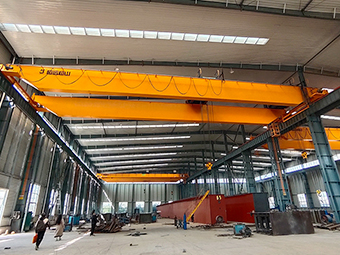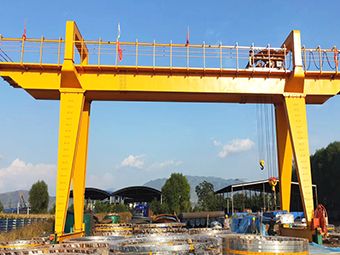launching gantry crane
.jpg)
There are three kinds of bridge erection machines in China, which are mostly used to erect steel bars or prestressed concrete beams in pieces.
1. Single girder bridge erecting machine
The boom of the single-girder bridge erecting machine is a box-shaped beam that cantilevers forward, and there is a foldable upright column (composed of left and right two-legged rods) at the front end. This kind of bridge erection machine can drive into the bridge position by itself under no-load state, and then straighten the front column and support it on the front bridge pier. When the beam piece (or the whole beam) moves along the boom, the boom is close to the state of simply supported beam.
When erecting a bridge, the single-girder bridge erecting machine must first transfer the beam piece from the railway flatbed car to the special girder carriage by using a special gantry crane, and then align the back end of the girder carriage and the bridge erecting machine, and use it to drive on the frame. The two beam trolleys on the boom of the bridge crane hoist the beam pieces, move forward along the boom, and reach the bridge position to drop the beam. In order to adapt to the curved bridge erection, the boom of the single girder bridge erection machine can swing a little in the horizontal plane. The beam placement method is the same as that used by the double cantilever bridge erection machine (beam shifting or track). The advantages of the single-girder bridge erecting machine are: the counterweight is cancelled, the locomotive push is no longer required, the bridge head fork line is not required for feeding the beam, the degree of mechanization is improved, and the safety performance is improved.
2. Double girder bridge erecting machine
The boom of the double-girder bridge erecting machine is composed of two left and right box beams, which penetrate through the fuselage and extend forward and rearward. At both ends there are folding uprights each consisting of two leg bars. There are two trolleys across the two box girders, which can travel longitudinally along the boom. The hanging beam trolley is placed on the truss and can travel laterally along the truss.
The beam pieces (or the whole beam) to be erected can be directly sent under the rear arm of the bridge erecting machine by the railway flatbed car. After being lifted by the hanging girder trolley, it is moved forward by the truss car, and then moved laterally by the hanging girder car, and then the beam is dropped. bit. After the beam is erected, the track must be laid immediately before the bridge erection machine can continue to work forward. The latter two bridge erection machines can generally hoist the pre-assembled rail row into place, so that the beam erection work will not be delayed due to the laying of the track.
The front and rear ends of this type of bridge erecting machine can hang and drop the beam; when changing the direction of the beam, there is no need to turn around; in order to adapt to the curved beam, the front and rear arms can swing in the horizontal plane; it is not necessary to move the beam or dial when erecting pieces. Road, the beam can be in place; "feeding the beam" does not require a bridge head or a special beam transport vehicle.
3. Double cantilever bridge erecting machine
The double cantilever bridge erecting machine was used earlier in the Soviet Union. When it was introduced in 1948, its front and rear arms were made of steel plate beams, and the lifting weight was 45 tons and 80 tons. In the 1950s, the double arm was changed to a frame, and the lifting weight was developed to 130 tons. This type of bridge erecting machine cannot be used by itself, and needs to be pushed by a locomotive. The forearm is used to suspend the beam, the rear arm is used to hoist the counterweight, and the front and rear arms cannot swing in the horizontal plane.
When erecting a bridge, it is often necessary to use a special 80-ton small flat car to transport the beam piece under the hook of the forearm of the bridge erecting machine (called "feeding beam") before it can be lifted; in order to facilitate the shunting operation, it is necessary to lay a fork line at the bridge head. . After the bridge erection machine lifts the beam, the axle load increases, and the newly-built embankment at the bridge head is relatively soft. Therefore, reinforcement measures must be taken for the driving section of the bridge erection machine's hanging girder.
related article
> How to Choose a Gantry Crane
> Correct Method of Erecting a Single Beam Overhead Crane
> Hook and Wire Rope Inquiry from Iran
> How many containers can a crane unload?
> The electric transfer cart ordered by Russian customers has been shipped
> Two Single Beam Overhead Cranes Order
> What is the difference between mobile crane and overhead crane?
> Overhead Crane is Working Well







.jpg)
.jpg)


.jpg)



